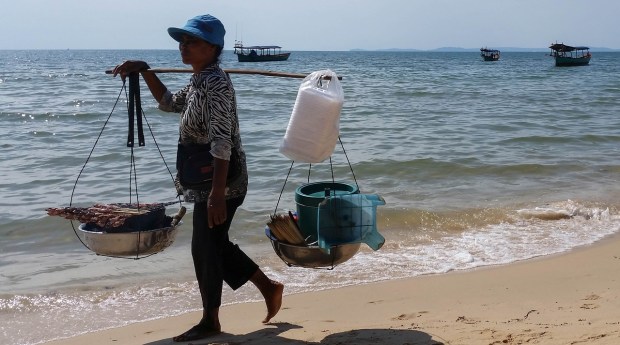Cambodia, officially known as the kingdom of Cambodia, is a country located in the southern portion of the Indochina Peninsula in Southeast Asia. It is 69,898 sq mi in area, and has a population of over 15 million. Bordered by Thailand, Laos and Vietnam, it has a 275 mile coastline along the gulf of Thailand. Phnom Penh is Cambodia’s capital and is home to the art deco central market, and situated on the riverfront are the glittering Royal Palace, Silver Pagoda and the National Museum.
Probably the most well known site in Cambodia is Angkor Wat situated in Siem Reap Province. The complex of temples make up the largest religious monument in the world, with the site measuring 162.6 hectares. Originally constructed as a Hindu Temple, it was gradually transformed to a Buddhist temple towards the end of the 12th century. As with most other ancient temples in Cambodia, Angkor Wat has faced extensive damage and deterioration by a combination of plant overgrowth, fungi, ground movements, war damage and theft.
The Vietnam war extended into the country with the US bombing of Cambodia from 1969-1973. Following the Cambodian coup of 1970, the deposed king gave his support to his former enemies, the Khmer Rouge. The Khmer Rouge emerged as a major power, taking Phnom Penh in 1975 and later carrying out the Cambodian Genocide from 1975 until 1979. Led by Pol Pot, they changed the official name of the country to Democratic Kampuchea. The new regime modelled itself on Maoist China during the Great Leap Forward, immediately evacuated the cities, and sent the entire population on forced marches to rural work projects. Estimates as to how many people were killed by the Khmer Rouge regime range from approximately one to three million; the most commonly cited figure is two million (about a quarter of the population).
Industry in Cambodia was badly disrupted by the war. Agriculture is the traditional mainstay of the Cambodian economy, however since the late 1990s, tourism is fast becoming Cambodia’s second largest industry. In 2015, there were just under 4.8 million tourists visits. The key attractions are Angkor, Tonlé Sap, Sihanoukville, Silver Pagoda and Siem Reap.
Recipes I came across during my research included Pleah (hot and sour beef salad), Amok Trey (fish curry), Bai Sach Chrouk (BBQ pork and rice), Kuy Teav (noodle soup), Chhnang Plerng (hot pot), Samlor Kako (soup made with spice paste, fish paste, meat, fish and vegetables) and Bai chha (fried rice). I decided to make Lok lak (stir fried marinated beef) served in lettuce leaves with rice. It was really enjoyable.
Rating: 9/10
Serves: 2
Prep time: 20 minutes + 1 hour marinating
Cook time: 20 minutes
300g sirloin steak, sliced (or you can use chicken if you prefer)
1 tsp sugar
1 tsp salt
1 tsp crushed black pepper
2/3 tsp chilli sauce (optional, preferably vietnamese or chinese chili sauce)
2 tsp oil + extra for cooking
2 tbsp soy sauce
2 tbsp oyster sauce
2 tbsp tomato ketchup
4 cloves of garlic, crushed
1 onion, chopped
A few lettuce leaves
Cooked rice
For the pepper sauce:
1 tsp sugar
1 tsp salt
1 tsp crushed back pepper
1 tsp crushed garlic
juice of a lime
Mix sugar, salt, pepper, oil, soy sauce, oyster sauce, ketchup and garlic in a sealable bag, add meat and coat thoroughly
Marinate in the fridge for 30 to 60 minutes
Mix salt, sugar, pepper and garlic in a bowl
Cook the rice
Add oil to a wok, fry the onion until brown and add steak and stir fry 5 minutes, until done (don’t over do it)
Mix in chili sauce as desired
Prepare a serving plate with a bed of lettuce and rice
Just before serving, squeeze the juice of 1/2 lime into the pepper sauce and stir lightly
Serve the steak over the rice and lettuce with pepper sauce on the side





















